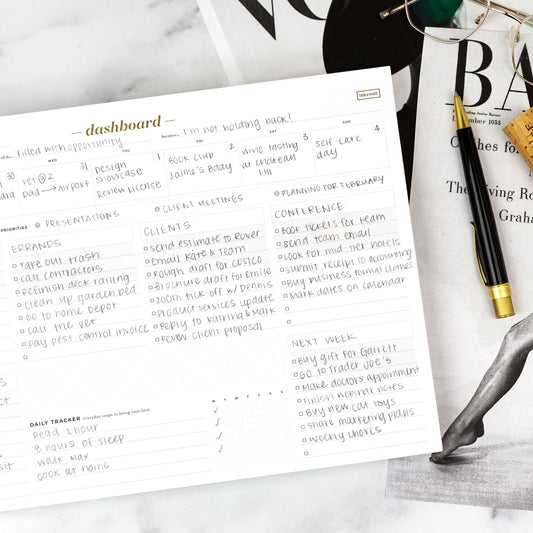This post is Part 4 of a 5-part series written by photographer and creative consultant Amelia Bartlett, about how she uses her Ink+Volt Planner.
New to our planner or looking for inspiration? Catch up on the series in Part 1, Part 2, and Part 3.
I consider brainstorming to be my favorite sport. It requires vigorous exploration and concise communication; it demands the quelling of the internal “no” and throws back the veil to reveal any number of scary parts of myself, which tend to be where my best ideas live.
To write freely, especially for me, is just as scary as speaking freely. Typically because there’s a rawness to my writing that if someone were to read it, I might as well vanish into a dot of humiliation.
So brainstorming is hard to do, especially when it involves putting pen to paper.
Dramatics aside, though, brainstorming is the perfect place to start when you’re on the hunt for an idea, a solution, or a source of inspiration, so it is worth doing if you really want to accomplish amazing things.
Using your Weekly Inspiration pages for brainstorming
Each week in your Ink+Volt Planner, there’s a full blank page for your free-writing called your Weekly Inspiration. These prompts are there to inspire you to think outside your patterns, to look beyond your plans, and see what else is there.
For me, brainstorming is like my free period in my planner. It’s the place I go to take the bumpers off my point-of-view and ride bareback through the valley of inspiration. That’s why I like to use these pages for brainstorming; whether or not I use the prompt, it is free and open space where I can explore a new idea.
It wasn’t always like that for me, and sometimes it still isn’t. Below is the biggest detractor which hinders my ability and drive to brainstorm. You may recognize them from your own experience:
The Naysayers
Whether it’s someone else’s voice or yours, hearing that you’re dreaming too big, that you won’t be able to accomplish what you want, or that something is (gasp) impossible can kill anyone’s creativity and make you want to hide in a hole, rather than dream about what is possible.
We know that these voices mean well. They want to protect us from getting let down, wasting our time and resources, or the worst: getting hurt. Of course, they may also be envious, afraid, or confused, but brainstorming isn’t about them. It’s bigger than that. It’s about what you’re committed to creating.
The Rules of Brainstorming
1. Defer judgment
Hemingway said it best: “Write drunk, edit sober”. No, I’m not saying you should brainstorm under the influence of a substance. I’m saying that writing and editing are separate processes and should be treated as such. Whether you’re brainstorming alone in your planner or working in a group, defer judgment of all ideas that come to the table. There are no bad ideas in brainstorming, as they say. No ifs, ands, or buts.
2. Wild, exaggerated, and out-of-this-world ideas are encouraged
In the brainstorming stage of any idea or endeavor, your goal is to stretch the bounds of what you think is possible. If we continue to travel the idea paths we’ve already traveled, we run the risk of shutting out the biggest and greatest ideas that have yet to be discovered. So, think bigger than possible. Think bigger than physics. You never know where those pathways could lead.
3. Quantity over quality
This goes against pretty much everything we’ve been taught, but for good reason – when it comes to ideas, to determine quality would require judgment (see rule #1), and therefore quantity is our best friend at this stage. You’re stretching the capacity of your imagination for ideas – the deeper go you with reckless abandon, the closer you get to something you’ve never seen before. You can analyze those crazy ideas later (you never know which ones will work!).
4. Build on others’ ideas
Even when brainstorming alone, ask yourself: how might others have looked at this prompt, problem, or opportunity? Try asking friends & family what their ideas might be. Step into the shoes of someone in the general field you’re brainstorming from or someone whose opinion you value. Allow their inspiration to inform your journey.
5. All ideas have equal worth
Without being too repetitive, this rule cannot be understated. There are no stupid questions, bad ideas, or wrong ways of going about brainstorming. A dear friend once attributed brainstorming to just “freaky flowing” from her creativity. This isn’t to say that every idea is a good one, but that all ideas are created equal in the arena of brainstorming.
How to bring brainstorming into your life, through your Ink+Volt Planner and beyond
I have a prompt in front of me from my Volt Planner. It reads:
Everyone has their own story, their own struggles. Seek to be understanding and ask questions before making assumptions. Strive to make a connection with others.
Sit quietly for a moment and feel that prompt. Acknowledge what pops into your brain and let those thoughts flow.
For me, I see people in my life. I think of past conversations that I had – mainly the ones that didn’t turn out the way that I’d hoped or left all involved feeling disconnected. What popped up for you?
With this prompt in mind, it is a perfect time to practice brainstorming. Even if your brain didn’t flood with visuals or feelings when you read it, there are ways to jog your mind and get the process started.
When brainstorming, there are a couple specific ways you can phrase a question that are open-ended and spark the fire of inspiration:
- How might I ___ …
- What are all the ways I could …
- How would ___ think about …
Let’s try. How might I create a connection with the people I will come in contact with this week?
My favorite way to brainstorm is the BRAIN DUMP. List as many possible answers to that query as you can. Take a minute or two and follow along with me, seeing if you can brainstorm twice, maybe three times what I have here.
-
- Compliment them on something they’ve shared with me
- Ask them how their family is
- Recall something positive about our last encounter
- Smile at them from across the room
- Send them a kind email
- Ask what they’re looking forward to this weekend
- Give them part of my lunch snack
- Call them just to say hi
- Share a funny photo of them in my social media feed
- Ask if there’s anything I can do to make their day easier
- …the list goes on if I let it!
When I get in the zone, which I call flow, I could brainstorm endlessly. What makes the experience richer for me, especially engaging in a brain dump as I call it, is to set a timer for 5, 10, or 15 minutes and see how much I can write in that time limit. What we’re doing when we brainstorming is called: divergent thinking.
di·ver·gent, adj. (of thought) using a variety of premises, especially unfamiliar premises, as bases for inference, and avoiding common limiting assumptions in making deductions.
When we diverge, we see how far we can go in as many directions as possible, reaching for the unknown with the hopes of happening upon something extraordinary. Divergent thinking results in a variable collection of opportunities, ideas, or solutions to pursue. But, we can’t follow all of them. Now what?
Ideas formed during divergent thinking can become next steps through convergent thinking.
con·ver·gent, adj. coming closer together, especially in characteristics or ideas.
Convergent thinking can be as easy or as complicated as the situation demands. In our circumstance, as we think about how we might connect with those who come into our lives, the answer can be as simple as circling our favorite ideas from our brain dump list, maybe 2 – 4, that we are willing and able to implement into our daily lives.
Then look at your planner and ask yourself: How do we make sure that these chosen ideas are implemented?
Put them in the calendar!
Write yourself a note at the top of the day of the week you’d like to give your idea a shot. It could look like *Send a kind email to ___* or *Call Aunt Rose and tell her you love her*. Small actions like this are the special power we hold to make someone’s day – including our own.
This week: Try brainstorming for at least 5 minutes and converge on 1 – 4 ideas you can implement
I’d love to hear about how you incorporate brainstorming into your life. Do you brainstorm for your job or your business? Have you tried brainstorming with your kids when they have big life decisions coming up? Share your thoughts and questions with us on Facebook – you never know who may be building from your ideas that you so generously share.
Amelia Bartlett is a photographer and creative consultant living and working in Tennessee, where she is converting a retired school bus into her home.
She is a new Ink+Volt Planner user, and has created a 5-part series sharing her journey of goal-setting and learning to use her planner. Follow along for inspiration, whether you’re a beginner or seasoned planner user! You can learn more about her work at amelia-bartlett.com.









